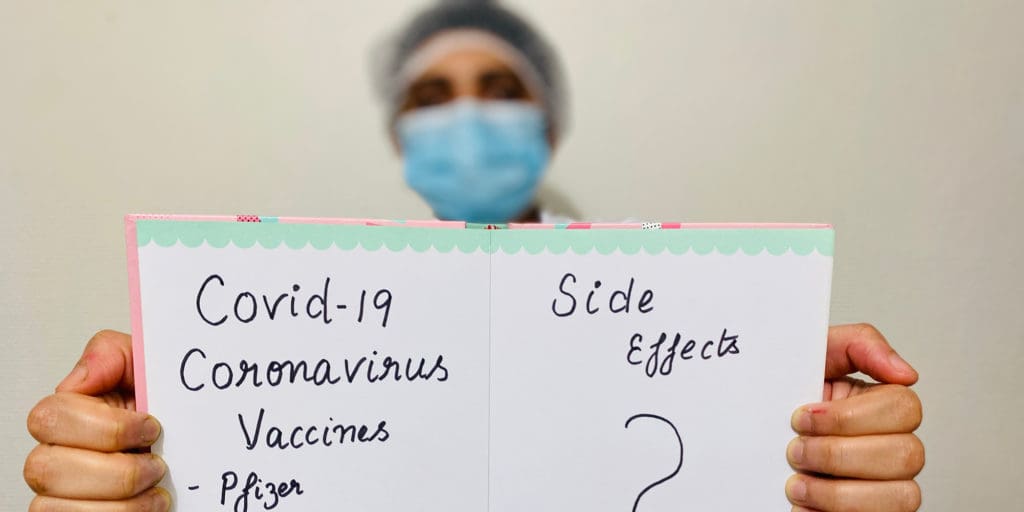As of Monday, March 8th, 2021, around 18% (roughly 58 million) of the United States population have received at least one dose of a COVID-19 vaccine (around 9% have been fully vaccinated). The approval of Johnson & Johnson’s single-dose vaccine has been able to catapult the hopes of nationwide vaccinations from July to now as early as May according to the Biden administration. With millions of people now ready to roll up their sleeves much sooner than expected, many are wondering what side effects to expect, and which to look out for.
Pfizer Vaccine
The Pfizer-BioNTech COVID-19 vaccine was the first vaccine approved for emergency use in the United States in late December of 2020. Rather than introducing a weakened version of the virus, like the common flu vaccine, mRNA vaccines teach cells how to create a protein that triggers an immune response inside the recipients’ body.
In its clinical trials, the vaccine was proven to be 95% effective at preventing COVID-19. Mild side effects within seven days of the first dose were common around the inoculation site, with more moderate aches and pains throughout the body following the second injection.
The vaccine is administered in two doses, 21 days apart, in the upper arm muscle and is safe for anyone over the age of 16. Side effects of the vaccine can range from mild to severe and are listed below.
- Pain, redness, and swelling around the injection site
- Tiredness
- Headache
- Muscle pain
- Chills
- Fever
- Nausea
More severe side effects of the Pfizer vaccine can include allergic reactions and Bell’s Palsy.
Moderna Vaccine
The Moderna COVID-19 vaccine was the second approved vaccine for emergency use in the United States and shares many similarities with the Pfizer vaccine. Moderna is an mRNA vaccine, like Pfizer, that is administered in the upper arm muscle in two doses 28 days apart.
In its clinical trials, the Moderna vaccine showed roughly the same effectiveness at preventing COVID-19 as the Pfizer Vaccine (94.1%). The vaccine is safe for anyone over the age of 18 years of age.
Normal side effects of the Moderna vaccine include much of the same as the Pfizer vaccine, such as fever and nausea, and are listed below.
- Pain, redness, and swelling around the injection site
- Tiredness
- Headache
- Muscle pain
- Chills
- Fever
- Nausea
More severe side effects of the Moderna vaccine can include Bell’s Palsy.
In both the Pfizer and Moderna vaccines, side effects were more common after the second dose and were reported more by younger adults.
J&J Vaccine
The Johnson & Johnson vaccine is the latest vaccine to join the emergency use category, being added to the list of approved vaccines on February 26, 2021. The vaccine showed an effectiveness of 66.3% in its clinical trials; however, studies have shown it has the same effect as both Pfizer and Moderna in preventing hospitalization and death due to COVID-19.
While only having been approved for a matter of days, millions of doses are expected to be ordered over the next few months, with Johnson and Johnson themselves stating that 100 million doses will be produced by early June.
While the J&J vaccine has a lower rate of effectiveness, it has been shown to produce more mild side effects than its counterparts. This may be due to the lower numbers of administered vaccinations, but early results show fewer reported side effects across multiple different groups.
The vaccine is safe for individuals over the age of 18. It is administered in one dose in the upper arm muscle. Normal side effects of the J&J are as follows.
- Fatigue
- Nausea
- Pain or swelling at the injection site
- Headache
- Muscle pain
- Chills
- Fever
What’s Not Normal?

Side effects are a normal part of vaccination. They are a sign that your body is building protection against a virus. The most common side effects across the three approved COVID-19 vaccines are fever, chills, and pain or swelling around the injection site. These are all unpleasant but are a reassuring indication that your immune system is responding to the vaccination.
Sometimes vaccinations can have adverse effects, occasionally resulting in hospitalization. If the redness or tenderness around the injection site worsens after 24 hours, or if side effects become worrying or do not subside after a few days, contact your doctor or local health care provider.
As with any vaccine, side effects can range anywhere from mild, to moderate, to severe. While side effects can be mild for some, others can experience more moderate or severe side effects. This list is meant to serve as a guideline to understand what the normal side effects of these vaccines are according to the Centers for Disease Control (CDC). Please contact a doctor if side effects worsen or severe side effects become apparent.
For a full list of vaccine information including ingredients and safety information, please visit the CDC’s website.
What Questions About COVID Vaccine Side Effects Do You Have?
Ask away in the comments section below!
What Covid-19 topics should we cover next?
Email us at info@painresource.com with your ideas.
Are you on Facebook?




